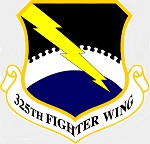Air Force 1 AF10117F USAF Lockheed-Martin F-22 Air Dominance Fighter - USAF Lockheed-Martin F-22 Air Dominance Fighter - 325th Fighter Wing, Tyndall AFB, Florida [Low-Vis Scheme] (1:72 Scale)
"The F-22's integrated avionics gives it first-look, first-shot, first-kill capability that will guarantee U.S. air dominance for the next 40 years."
- Lockheed-Martin, prime contractor for the F-22 Air Dominance Fighter
 Intended to be the leading American advanced tactical fighter in the early part of the 21st century, the Raptor is the world's most expensive fighter to date costing about $120 million per unit, or $361 million per unit when development costs are added. Part of the reason for the decrease in the requirement is that the F-35 Lightning II uses much of the technology used on the F-22, but at a much more affordable price. To a large extent the cost of these technologies is only lower for the F-35 because they have already been developed for the F-22. Had the F-22 not been developed, the costs of these technologies for the F-35 would have been significantly higher.
Intended to be the leading American advanced tactical fighter in the early part of the 21st century, the Raptor is the world's most expensive fighter to date costing about $120 million per unit, or $361 million per unit when development costs are added. Part of the reason for the decrease in the requirement is that the F-35 Lightning II uses much of the technology used on the F-22, but at a much more affordable price. To a large extent the cost of these technologies is only lower for the F-35 because they have already been developed for the F-22. Had the F-22 not been developed, the costs of these technologies for the F-35 would have been significantly higher.
Next generation technology abound in the Raptor. For starters, the F-22's dual Pratt & Whitney F119-PW-100 turbofan engines with afterburners incorporate thrust vectoring. Thrust vectoring is in the pitch axis only, with a range of 20 degrees. The maximum thrust is classified, though most sources place it at about 35,000 lbf (156 kN). Maximum speed is estimated to be Mach 1.72 in supercruise mode and without external weapons; with afterburners, it is 'greater than Mach 2.0' (2120 km/h), according to Lockheed Martin. The Raptor can easily exceed its design speed limits, particularly at low altitudes; max-speed alerts help prevent the pilot from exceeding the limits. Gen. John P. Jumper, U.S. Air Force Chief of Staff, September 6th, 2001 to September 2nd, 2005, flew the Raptor faster than Mach 1.7 without afterburners on January 13th, 2005. The absence of variable intake ramps may make speeds greater than Mach 2.0 unreachable, but there is no evidence to prove this. Such ramps would be used to prevent engine surge, but the intake itself may be designed to prevent this. Former Lockheed Raptor chief test pilot Paul Metz says the Raptor has a fixed inlet. Paul Metz has also stated that the F-22 has a top speed greater than 1600 mph (Mach 2.42) and its climb rate is faster than the F-15 Eagle. This is because the F-22 is one of the few fighter aircraft with a thrust to weight ratio significantly greater than 1:1.
The true top-speed of the F-22 is largely unknown, as engine power is only one factor. The ability of the airframe to withstand the stress and heat from friction is a key factor, especially in an aircraft using as many polymers as the F-22. However, while some aircraft are faster on paper, the internal carriage of its standard combat load allows the aircraft to reach comparatively higher performance with a heavy load over other modern aircraft due to its lack of drag from external stores. It is one of a handful of aircraft that can sustain supersonic flight without the use of afterburner augmented thrust. The fuel usage from using afterburners would have greatly reduces its flight time.
The F-22 is highly maneuverable, at both supersonic and subsonic speeds. The usage of the F-22's thrust vectoring nozzles allows the aircraft to turn tightly, and perform extremely high alpha maneuvers such as Pugachev's Cobra and the Kulbit. The F-22 is also capable of maintaining a constant angle of attack of over 60.
Avionics include Raytheon and Northrop Grumman AN/APG-77 Active Electronically Scanned Array (AESA) radar, possibly the most capable radar in active service, with both long-range target acquisition and low probability of interception of its own signals by enemy aircraft.
This particular 1:72 scale replica of a F-22 that was attached to the 325th Fighter Wing, then deployed to Tyndall AFB, Florida.
Now in stock!
Dimensions:
Wingspan: 7-1/2-inches
Length: 10-1/4-inches
Release Date: December 2024
 Historical Account: "Installation of the Future" - The 325th Fighter Wing's primary mission is to project unrivaled combat air power for America. The wing is currently transitioning to the F-35A Lightning II. When the transition is complete, the 325th Fighter Wing will become the Air Force's newest operational fighter wing with three F-35A squadrons tasked to maintain combat readiness in support of national defense.
Historical Account: "Installation of the Future" - The 325th Fighter Wing's primary mission is to project unrivaled combat air power for America. The wing is currently transitioning to the F-35A Lightning II. When the transition is complete, the 325th Fighter Wing will become the Air Force's newest operational fighter wing with three F-35A squadrons tasked to maintain combat readiness in support of national defense.
The 325th Fighter Wing is host to 20 tenant organizations from multiple Major Commands and across several military mission sets located at Tyndall Air Force Base, Fla. The wing comprises the 325th Operations Group, 325th Maintenance Group, 325th Mission Support Group and 325th Medical Group.
Tyndall Air Force Base is currently undergoing a $4.7 billion dollar rebuild after sustaining a direct hit from Hurricane Michael in 2018. When the rebuild is complete, Tyndall will be the Air Force's first 21st Century "Installation of the Future."


